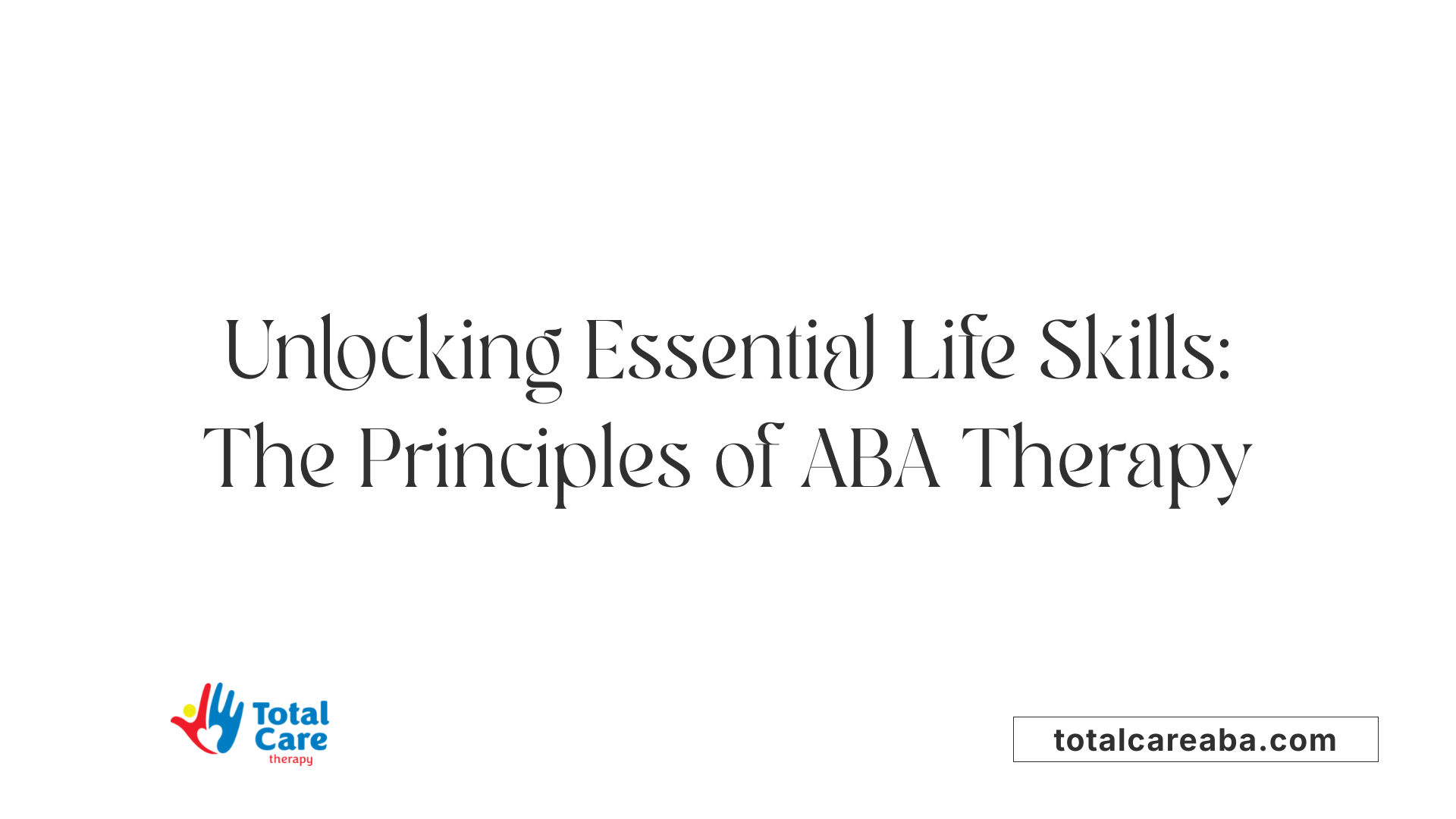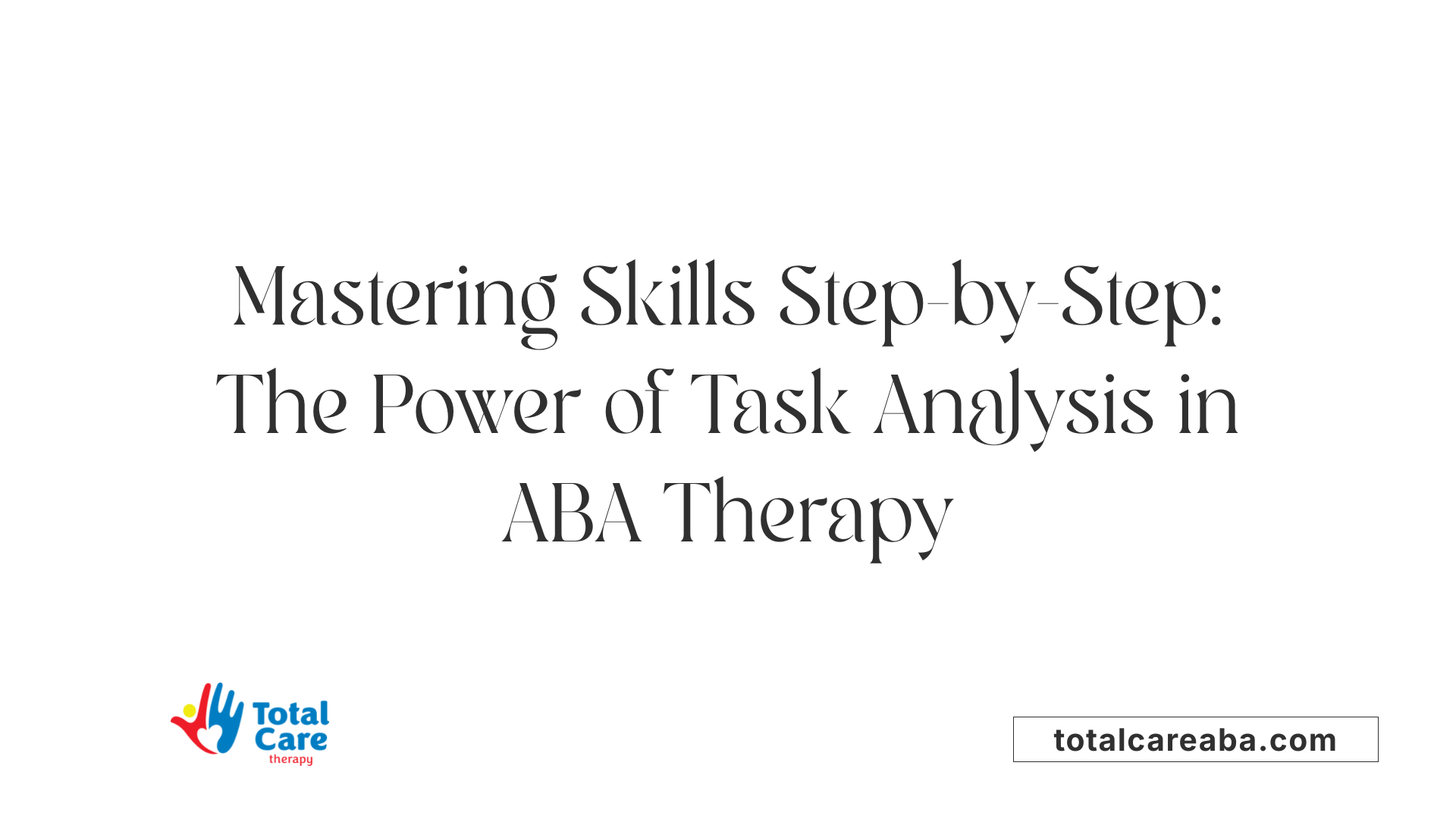How ABA Therapy Is Used to Teach Functional Life Skills
Empowering Daily Life Through ABA Therapy
How ABA Therapy Is Used to Teach Functional Life Skills
Understanding the Role of ABA in Functional Skills Development
Applied Behavior Analysis (ABA) therapy provides critical support in developing functional life skills for individuals, especially those with autism. Functional skills, encompassing communication, social interactions, and daily living abilities, are essential for improving quality of life and fostering independence. This article explores how ABA therapy effectively teaches these skills, highlighting its evidence-based methods and successful outcomes.
Key Principles of ABA Therapy in Teaching Life Skills

How is ABA therapy applied to teach functional life skills?
ABA therapy is effectively applied to teach functional life skills through structured and evidence-based methods. These principles focus not only on promoting essential skills but also on enhancing the overall quality of life for individuals, particularly those with autism spectrum disorder (ASD).
One of the central methods is Natural Environment Teaching (NET). This approach enables children to learn vital skills in familiar settings, such as home or community, thereby fostering independence through engaging in everyday routines. This contextual learning allows skills to transfer naturally into daily activities, improving the child's confidence and self-sufficiency.
Another significant technique is Social Skills Training, which is designed to help individuals interpret social cues and improve their communication. Social interactions become easier as children learn to engage in meaningful relationships, understand emotions, foster empathy, and navigate conflicts effectively.
In addition, Discrete Trial Teaching (DTT) is utilized to break down complex tasks into smaller, manageable steps. This task analysis simplifies learning processes, facilitating gradual mastery of skills like dressing or brushing teeth over time. Each step is reinforced with positive feedback, enhancing motivation and promoting the recurrence of these desirable behaviors.
Overall, ABA therapy combines engaging activities with structured methodologies, making skill acquisition enjoyable and accessible for children while equipping them with vital life skills they can utilize throughout their lives.
Life Skills Taught Through ABA Therapy

What life skills does ABA therapy help teach?
ABA therapy helps teach a wide range of life skills vital for independence. It focuses on daily living skills, which include:
- Personal Hygiene: Teaching routines like brushing teeth and bathing.
- Dressing: Learning to select and put on appropriate clothing.
- Meal Preparation: Involving simple cooking and understanding nutrition.
- Household Chores: Building skills for cleaning, laundry, and tidying up.
In addition to these practical skills, ABA therapy enhances communication skills. This includes:
- Verbal Communication: Expressing needs and ideas verbally.
- Non-Verbal Communication: Using gestures and understanding body language.
- Social Skills: Developing the ability to interact well with others, share, and even empathize.
These abilities are vital for everyday interactions and enhancing quality of life for individuals with autism.
Benefits for individuals with autism
The benefits of functional skills learned through ABA therapy are profound. By mastering these life skills, individuals can achieve a greater degree of independence, which significantly boosts their self-esteem and confidence. Furthermore, skills such as communication and social interaction help them navigate relationships and community settings more effectively.
Overall, by utilizing techniques like task analysis and positive reinforcement, ABA therapy not only fosters a sense of competence but also allows individuals to engage more meaningfully with the world around them.
Comprehensive Approach to Communication and Social Skills

What is functional communication training in ABA therapy?
Functional communication training (FCT) embodies a vital aspect of Applied Behavior Analysis (ABA) aimed at enhancing communication skills among individuals with autism spectrum disorder (ASD) and other developmental challenges. Introduced by Carr and Durand in 1985, FCT serves as a proactive intervention to replace challenging behavioral patterns with effective communication methods.
Key components of FCT include:
- Alternative Communication Methods: Training often involves the use of sign language, gestures, and visual aids, such as the Picture Exchange Communication System (PECS).
- Functional Communication Assessment: This assessment is crucial to uncover the motivations behind challenging behaviors, enabling therapists to identify appropriate communication responses tailored to the individual's needs.
- Positive Reinforcement and Shaping Techniques: By focusing on reaffirming effective communication efforts, FCT fosters positive interactions and minimizes the likelihood of inappropriate behaviors. Ultimately, FCT aims to cultivate better social engagement and greater independence through improved communication capabilities.
How does ABA therapy enhance social skills?
ABA therapy places significant emphasis on social skill development, targeting the ability of individuals with ASD to recognize social cues, comprehend emotions, and foster relationships. Some key areas of focus include:
- Understanding Social Cues: Individuals learn to interpret verbal and non-verbal signals, which enhances their relational dynamics.
- Empathy and Friendship Skills: ABA encourages the development of empathy, enabling individuals to connect with peers and form meaningful friendships.
- Conflict Resolution: Skills for navigating conflicts are taught, equipping individuals to manage social interactions positively.
Through structured learning experiences, ABA therapy not only enhances communication but also bolsters the overall social competence of individuals, facilitating their ability to engage confidently within their communities.
This comprehensive approach ensures that essential life skills related to communication and social interaction are effectively taught, aiding personal development and independence.
Core Functional Skills in ABA Therapy
What are considered functional skills in the context of ABA therapy?
Functional skills in ABA therapy are practical abilities crucial for enhancing an individual’s daily life and overall well-being. These skills are categorized into several key areas:
- Communication Skills: This includes both verbal (spoken language) and non-verbal (gestures, body language) methods, essential for expressing needs and engaging socially.
- Safety Skills: Recognizing how to navigate potentially dangerous situations ensures individuals can protect themselves in various environments.
- Leisure Skills: Engaging in appropriate social interactions and independent play promotes healthy social relationships.
- Self-care Skills: Tasks surrounding personal hygiene and routines, such as dressing and grooming, foster independence and confidence.
- Vocational Skills: Preparing individuals for future employment is fundamental, encompassing money management and basic job readiness skills.
Teaching these skills must be individualized, as each learner presents unique needs and potential. Techniques such as Natural Environment Training and Task Analysis are effective in delivering these lessons. Moreover, reinforcement strategies, including rewards and praise, significantly enhance motivation and maintain engagement, especially for young learners.
These functional skills are integral to helping individuals with autism spectrum disorder (ASD) navigate daily life more effectively, ultimately promoting a better quality of life.
Application of Positive Reinforcement and Prompting in ABA Therapy
Role of Positive Reinforcement
Positive reinforcement is a cornerstone of Applied Behavior Analysis (ABA) therapy. It involves rewarding desirable behaviors to encourage their recurrence. For instance, after a child successfully completes a self-care task, they might receive verbal praise or a small reward, making them more likely to repeat the task independently in the future. This creates a positive feedback loop that bolsters motivation and engagement in learning. Reinforcement can be tailored to the individual’s preferences, and as skills improve, the frequency of rewards can gradually decrease, promoting further independence.
Prompting Techniques
Prompting is an essential strategy in ABA therapy, designed to assist individuals in successfully completing tasks. It can take various forms: verbal prompts (spoken cues), visual prompts (pictures or symbols), and physical prompts (guiding the person’s hand). Initially, these prompts help individuals engage in activities such as brushing their teeth or getting dressed by providing necessary guidance. Over time, prompts are purposely faded, encouraging individuals to perform tasks independently. This method ensures that learners can adapt and master skills without excessive reliance on support, fostering long-term independence.
Adapting ABA Therapy for Individual Needs
Personalization of ABA Therapy
ABA therapy is renowned for its flexibility, adapting to the unique requirements of each individual. By recognizing that no two learners are the same, therapists create personalized plans that account for varying abilities and challenges. This approach enhances the likelihood of success in developing essential life skills.
Tailoring Therapy Plans
Therapy plans are crafted with specific goals that center on improving communication, social skills, and self-care. Factors such as the individual’s age, interests, and existing competencies inform the customization process. Techniques like task analysis and positive reinforcement are strategically used to ensure that the learning experience is effective and engaging.
| Aspect of Customization | Description | Impact |
|---|---|---|
| Individual Assessments | Comprehensive evaluations identify specific strengths and needs. | Tailored teaching strategies can be implemented more effectively. |
| Goal Setting | Realistic, achievable objectives based on assessed skills. | Encourages motivation and ongoing progress. |
| Progress Monitoring | Continuous data collection to refine strategies as needed. | Ensures that interventions remain relevant and effective. |
By maintaining a focus on personalization, ABA therapy fosters a supportive environment that significantly boosts the quality of life for individuals with autism.
Task Analysis and Breaking Down Skills

Task Analysis Techniques
Task analysis is a fundamental strategy used in Applied Behavior Analysis (ABA) therapy to teach complex skills. This technique involves breaking down an activity into smaller, more manageable steps, enabling individuals to learn each component sequentially and with greater ease. For example, teaching someone to brush their teeth can be simplified into specific steps such as:
- Gathering supplies: toothbrush, toothpaste, and water.
- Applying toothpaste: placing an appropriate amount on the toothbrush.
- Brushing technique: demonstrating how to brush all areas of the mouth.
- Rinsing: using water to rinse both the mouth and the toothbrush.
Using this structured approach ensures that each step is mastered before advancing to the next.
Step-by-Step Skill Teaching
Incorporating step-by-step instruction is crucial for effective learning in ABA therapy. Each skill is not only broken down into manageable parts but also reinforces independence as the individual progresses. Techniques such as prompting (including verbal or visual cues) are used initially to guide through each step. As the learner gains more confidence and proficiency, prompts are gradually faded.
Visual supports, like checklists and schedules, further enhance the teaching process, as they allow individuals to track their progress and perform tasks with minimal assistance. This method promotes autonomy and helps individuals apply learned skills across various settings, ultimately leading to greater independence in daily life.
Incorporating Real-World Scenarios in ABA Training
Natural Environment Training
Natural Environment Training (NET) is an essential component of Applied Behavior Analysis (ABA) therapy that leverages real-life settings to teach and reinforce skills. The aim is to help children generalize what they’ve learned in structured therapy sessions to everyday situations. By engaging with familiar contexts, children can practice communication, social interactions, and self-care in environments where these skills are necessary.
Using Real-Life Settings
Utilizing real-life settings during ABA training not only enhances retention but also boosts confidence. Practicing in settings like homes, parks, or grocery stores allows children to interact with peers and adults, making learning more applicable and meaningful.
Benefits include:
- Improved skill application in social situations
- Increased motivation by practicing in enjoyable settings
- Enhanced independence through hands-on experiences
Overall, incorporating real-world scenarios in ABA training creates a dynamic learning atmosphere that supports essential life skills.
Tracking Progress and Adapting Strategies

Assessment and Data Collection
In Applied Behavior Analysis (ABA) therapy, continuous assessment and systematic data collection are essential components for tracking the progress of individuals. This process involves gathering quantitative and qualitative data during therapy sessions, which allows Board Certified Behavior Analysts (BCBAs) to identify existing skill levels and determine areas needing improvement.
Multiple assessment methods can be employed, including parental checklists and direct behavioral observations, providing a comprehensive overview of the individual's capabilities.
Monitoring Individual Progress
Ongoing monitoring of progress is vital for the effectiveness of ABA therapy. Therapists use collected data to evaluate how well individuals are acquiring new skills and whether current strategies are effective. This evaluation enables them to make necessary adjustments to individualized therapy plans.
Through progress tracking, therapists can celebrate small victories and refine techniques, ensuring skill acquisition is tailored to the unique needs of each person. This adaptive approach not only empowers individuals by fostering independence in daily living skills but also enhances overall confidence and quality of life.
By embracing ongoing assessments, ABA therapy remains a dynamic and responsive intervention, adapting strategies to foster the greatest personal growth.
Conclusion: The Impact of ABA on Independence and Quality of Life
By utilizing methodologies such as Positive Reinforcement, Task Analysis, and Functional Communication Training, ABA therapy provides a robust framework for teaching functional life skills. This approach not only aids in the development of communication, social, and daily living skills but also promotes independence and enhances the quality of life for individuals with autism. The demand for adaptable and personalized interventions ensures ABA remains a cornerstone of treatment, empowering individuals to transition from childhood to adulthood while achieving their fullest potential.
References
- Functional Skills in ABA: An Overview
- Applied Behavior Analysis (ABA) | Autism Speaks
- ABA Therapy and Life Skills for Everyday Independence
- Ways ABA Therapy Can Help with Life Skills - Behavioral Innovations
- "How ABA Therapy Supports Functional Life Skills" Discuss How ...
- Teaching Kids Life Skills with ABA Therapy - ABATherapistJobs.com
- What Is ABA Therapy? - CABS Autism and Behavioral Specialists








